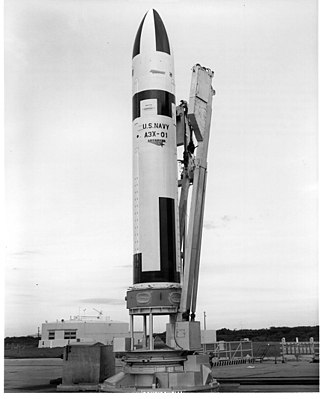
The Avro Blue Steel was a British air-launched, rocket-propelled nuclear armed standoff missile, built to arm the V bomber force. It allowed the bomber to launch the missile against its target while still outside the range of surface-to-air missiles (SAMs). The missile proceeded to the target at speeds up to Mach 3, and would trigger within 100 m of the pre-defined target point.

The UGM-27 Polaris missile was a two-stage solid-fueled nuclear-armed submarine-launched ballistic missile (SLBM). As the United States Navy's first SLBM, it served from 1961 to 1980.

The Convair F-106 Delta Dart was an all-weather interceptor aircraft designed and produced by the American aircraft manufacturer Convair.

The LGM-118 Peacekeeper, originally known as the MX for "Missile, Experimental", was a MIRV-capable intercontinental ballistic missile (ICBM) produced and deployed by the United States from 1985 to 2005. The missile could carry up to twelve Mark 21 reentry vehicles, each armed with a 300-kiloton W87 warhead. Initial plans called for building and deploying 100 MX ICBMs, but budgetary concerns limited the final procurement; only 50 entered service. Disarmament treaties signed after the Peacekeeper's development led to its withdrawal from service in 2005.

Convair, previously Consolidated Vultee, was an American aircraft-manufacturing company that later expanded into rockets and spacecraft. The company was formed in 1943 by the merger of Consolidated Aircraft and Vultee Aircraft. In 1953, it was purchased by General Dynamics, and operated as their Convair Division for most of its corporate history.

The North American XF-108 Rapier was a proposed long-range, high-speed interceptor aircraft designed by North American Aviation intended to defend the United States from supersonic Soviet strategic bombers. The aircraft would have cruised at speeds around Mach 3 with an unrefueled combat radius over 1,000 nautical miles, and was equipped with radar and missiles offering engagement ranges up to 100 miles (160 km) against bomber-sized targets.

The W25 was a small nuclear warhead that was developed by the Los Alamos Scientific Laboratory for air-defense use. It was a fission device with a nominal yield of 1.7 kt.

The Douglas AIR-2 Genie was an unguided air-to-air rocket with a 1.5 kt W25 nuclear warhead. It was deployed by the United States Air Force and Canada during the Cold War. Production ended in 1962 after over 3,000 were made, with some related training and test derivatives being produced later.

The Hughes AIM-4 Falcon was the first operational guided air-to-air missile of the United States Air Force. Development began in 1946; the weapon was first tested in 1949. The missile entered service with the USAF in 1956.

The AIM-26 Falcon was a larger, more powerful version of the AIM-4 Falcon air-to-air missile built by Hughes. It is the only guided American air-to-air missile with a nuclear warhead to be produced; the unguided AIR-2 Genie rocket was also nuclear-armed.

The AGM-129 ACM was a low-observable, subsonic, turbofan-powered, air-launched cruise missile originally designed and built by General Dynamics and eventually acquired by Raytheon Missile Systems. Prior to its withdrawal from service in 2012, the AGM-129A was carried exclusively by the US Air Force's B-52H Stratofortress bombers.

Nuclear weapons delivery is the technology and systems used to place a nuclear weapon at the position of detonation, on or near its target. Several methods have been developed to carry out this task.

The Convair XGAM-71 Buck Duck was an air-launched decoy missile that was developed by Convair in the early 1950s. It was intended to have the same radar signature as the Strategic Air Command's B-36 bomber, thereby allowing it to disrupt the enemy's air defenses and dilute their effort to shoot down an incoming bomber fleet.

The GAM-63 RASCAL was a supersonic air-to-surface missile that was developed by the Bell Aircraft Company. The RASCAL was the United States Air Force's first nuclear armed standoff missile. The RASCAL was initially designated the ASM-A-2, then re-designated the B-63 in 1951 and finally re-designated the GAM-63 in 1955. The name RASCAL was the acronym for RAdar SCAnning Link, the missile's guidance system. The RASCAL project was cancelled in September 1958.

Project E was a joint project between the United States and the United Kingdom during the Cold War to provide nuclear weapons to the Royal Air Force (RAF) until sufficient British nuclear weapons became available. It was subsequently expanded to provide similar arrangements for the British Army of the Rhine. A maritime version of Project E known as Project N provided nuclear depth bombs used by the RAF Coastal Command.

Pye Wacket was the codename for an experimental lenticular-form air-to-air missile developed by the Convair Division of the General Dynamics Corporation in 1957. Intended as a defensive missile for the B-70 Valkyrie Mach 3 bomber, the program saw extensive wind-tunnel testing and seemed promising; however, the cancellation of the B-70 removed the requirement for the missile, and the project was cancelled.

The High Virgo, also known as Weapons System 199C (WS-199C), was a prototype air-launched ballistic missile (ALBM) jointly developed by Lockheed and the Convair division of General Dynamics during the late 1950s. The missile proved moderately successful and aided in the development of the later GAM-87 Skybolt ALBM. It was also used in early tests of anti-satellite weapons.
The Wagtail missile, also known as "Wag Tail", was a short-range nuclear missile developed in the late 1950s by Minneapolis-Honeywell under a contract awarded by the United States Air Force. Intended for use as an auxiliary weapon by bomber aircraft, the missile was successfully test fired in 1958, but the program was cancelled in the early 1960s.

The XSSM-A-5 Boojum, also known by the project number MX-775B, was a supersonic cruise missile developed by the Northrop Corporation for the United States Air Force in the late 1940s. Intended to deliver a nuclear warhead over intercontinental range, the project was determined to be too ambitious given technical difficulties with the SM-62 Snark which it was planned to follow, and it was canceled in 1951.


















